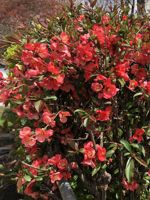Mon-Fri 9am - 5pm Mountain time
Japanese Quince vs Blue Flax
Chaenomeles japonica
Linum lewisii
NOT AVAILABLE THIS SEASON - MIGHT RETURN
NOT AVAILABLE THIS SEASON - MIGHT RETURN
Japanese Quince has bright, orange to red showy flowers that bloom in early spring. The flowers appear before the leaves and may continue to bloom after leaves emerge. Flowers grow on old wood, so pruning after flowering will help to promote new growth next spring. They produce yellow-green fruit that taste bitter when eaten raw, typically they are better suited for making preserves.
It can be used as a stand alone ornamental shrub, as a low hedge, or can be trained to grow against a wall. In late winter, branches of Japanese Quince can be cut and brought indoors where they will bloom on their own. They are deer and rabbit tolerant. The branches are spiny making them well suited for keeping unwanted wildlife away.
Blue Flax is a native perennial wildflower known for its blue to violet flowers. Each flower lasts just a single day, but new blooms appear continuously, providing weeks of colour. This extended flowering period provides a reliable display from late spring into summer and attracts a variety of pollinators.
They can self-seed readily, so removing spent blooms helps manage their spread. Birds feed on the seeds, and when cooked, they are edible and are described as having a mild, nutty flavour. The plant grows in loose clumps with slender stems and fine foliage. Young plants are leafy, but as they mature, most leaves are shed.
Blue Flax grows well in a wide range of soils, including poor or sandy conditions, and is drought-tolerant once established. The deep root system helps to stabilize soil and prevent erosion. They are well-suited for pollinator gardens, restoration, naturalization, and xeriscaping projects.
Japanese Quince Quick Facts
Blue Flax Quick Facts
Toxicity: toxic to some animals, raw seed toxic

